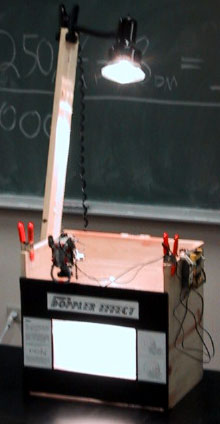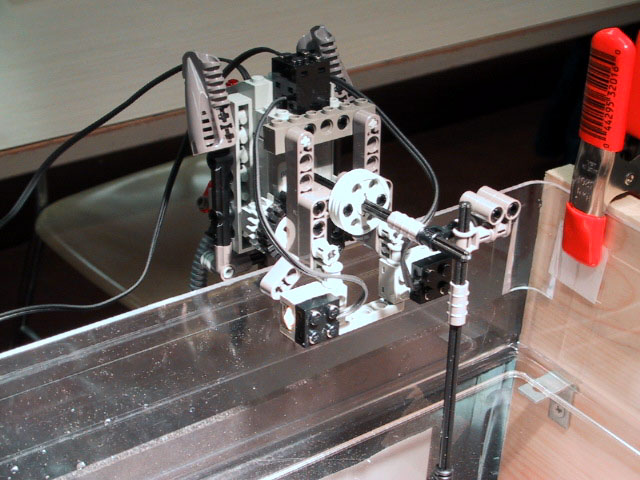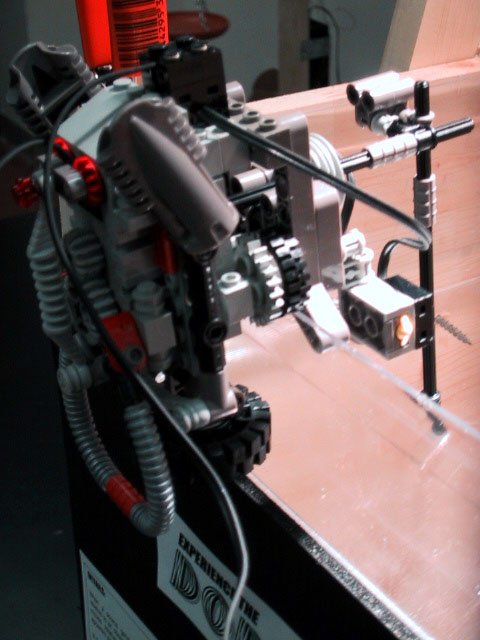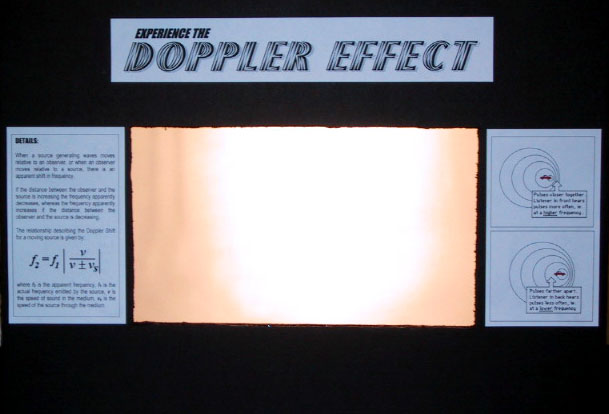



Eric Gundersen
Hui Dai
 |
 |
 |
 |
The Doppler effect is an observed change in frequency of an acoustic or electromagnetic wave due to relative motion of the source and/or observer. We designed a device to simulate this effect. Our illustration provides both visual and aural stimuli granting an entertaining and educational experience. The physical movement of water is used to accurately represent the movement of soundwaves in air. In this exhibit, a computer controlled cart is used to agitate the water in a precise manner to create ripples (waves) that simulate the movement of a source of sound. These ripples are then projected onto a screen where visualization of the Doppler effect is possible.
Heard an ambulance go by recently? Remember how the siren's pitch changed as the vehicle raced towards, then away from you? First the pitch became higher, then lower. Originally discovered by the Austrian mathematician and physicist, Christian Doppler (1803-53), this change in pitch results from a shift in the frequency of the sound waves, as illustrated in the following animation.
As the ambulance approaches, the sound waves from its siren are compressed towards the observer. The intervals between waves diminish, which translates into an increase in frequency or pitch. As the ambulance recedes, the sound waves are stretched relative to the observer, causing the siren's pitch to decrease. By the change in pitch of the siren, you can determine if the ambulance is coming nearer or speeding away. If you could measure the rate of change of pitch, you could also estimate the ambulance's speed.
By analogy, the electromagnetic radiation emitted by a moving object also exhibits the Doppler effect. The radiation emitted by an object moving toward an observer is squeezed; its frequency appears to increase and is therefore said to be blueshifted. In contrast, the radiation emitted by an object moving away is stretched or redshifted. As in the ambulance analogy, blueshifts and redshifts exhibited by stars, galaxies and gas clouds also indicate their motions with respect to the observer.
When making an educational exhibit, we wanted to explain a common phenomenon that, while familiar is still mysterious to many. We think the Doppler Effect is an excellent example of this. People know it well but still may not know exactly how it occurs. Thus we chose the Doppler Effect as the topic of our exhibit. We want to recreate the scene of an ambulance speeding by and give a satisfying explanation of why it sounds the way that it does.
Our design is based on a cart running on the edge of a water tank. When the exhibit begins, the cart runs from one end of the tank to another end. The cart both emits a changing pitch of sound and agitates the water simultaneously. The ripples are projected on to the screen by a light.
It's hard to achieve the genuine effect of the Doppler. After some calculations we found that it is impossible to get the length as well as the speed required in a small exhibit space. But it is relatively simple to just simulate the Doppler effect. So we decided to force the change in pitch on the cart as it moves. The pitch increases/decreases as the cart comes approaches and retreats from the centerpointce. But is a sound effect alone enough to impress the audience? It would be great to achieve a visible effect as well.
To make it compelling and successful, it necessary to find some way to display the Doppler effect and make it visible to the audience. Since water ripples are also a kind of the wave, they exhibit some of the same properties as sound or electromagnetic waves. And they are relatively easy to see or be projected. Thus it should help a lot to used this to illustrate the Doppler effect.
The cart in the project is used to simulate a moving source of sound, like an ambulance. It runs along the edge of the water tank and generates the siren sound like the ambulance does. But we still need a way it to create ripples in the water as it moves.
The design of the cart is relatively simple. What we want is to make the cart move along the edge of the water tank. The first problem is how to have the cart running on such a thin edge of the water tank. We spent a great deal of time figuring out how to solve this problem. There are many difficulties here. The first one is how to make the cart move along such thin edge. The second one is how to make the cart keep balance while rolling on it. First we consider let the cart move on some planes parallel to the top of the tank. But it proves hard to control the direction of the cart as well as building the plane. Still another consideration is not using the wheel, using the pulley and the thread to pull the cart instead.
Here are some of our designs: The first design is to use 2 primary wheels to move on the edge. To keep the balance and reduce friction at the same time, we use 4 wheels on each side to fasten the cart of the edge of the tank. But quickly we found that the friction is too big to make the cart move. So we change the whole ideas of the cart design. The latest design is the result of building 5 prototypes, and is by far the best. It is the lightest and most stable of the designs. And it uses the weight of the motor as a necessary counterbalance to keep the stability when in motion. The friction is really a problem. We did many experiments and finally were able to maintain friction at a reasonable level.
Another problem about the cart is its moving speed. It should not be too fast, otherwise the ripples will interfere with each other. It can't be too slow, either. After several tests, we also find some way to make it move in a reasonable speed. We also want it to switch directions when it reachs the endpoints of the tank's edge. To achieve this effect, we added two touch sensors on both sides of the cart. Whenever the cart reaches the end, the touch sensor will be tripped by the side of the water tank. The RCX unit then sends the instruction to make the cart go to reverse and loop the circuit continuously.
The third problem is how to make the cart agitate the water. We attach two rods together to form an "L" shape. and fasten one end of the horizontal rod to the cart. The other end, which was attached to the verticle rod, extends to a point over the water tank. The verticle stick is adjuected to touch the water and generate the ripples. By adjusting the height of the verticle stick, we can control the amplitude of the ripples. Thus we can control the effect of the image effect on the screen.
Lastly, is the problem of the sound. As it is impossible to generate the genuine effect, we wrote a small program on the RCX unit to simulate the changes in pitch consistent with the Doppler effect. In our design, the audience sees only on the front side of the stage. When the cart approaches the center, according to the Doppler, the pitch of the sound should decrease.
The function of Water Tank is to hold the water, which is used to generate the ripple to make the Doppler effect visible.
1. The first concern about the water tank is its size. As we referred above, it's impossible to actually build the tank with the length long enough to get the genuine Doppler effect. It would be too expensive. Thus we chose a tank of normal size. We wanted to simulate the Doppler effect by programming. Although this approach is easy to achieve. It has several drawbacks, i.e. first, you can only listen the sound from one side. Because the sound effect has no relationship with the your place. It means wherever you stand, the sound effect will be the same. Another issue is that we can't achieve the genuine sound effect of the real life i.e. the increaing speed or decreasing speed of the pitch, because the length is too short and the speed is too slow.
2. As we want to project the ripple movement out to the screen, we have to consider the material of the tank.Of course the side/floor of the water tank should all be transparent. There is still the consideration of the reflection and refraction here. Thus we use the transparent plastic tank.
3. Finally, here are several problems about the projection
1. At first, we can't decide which can achieve the better effect, thick water or just a thin layer of water. After making some experiments, we found that the effect of projection is much better using just a thin layer.
2. The second problem is to find the place of the screen. We have some time in figuring out which direction is the best for the light to go out of the water. It should also be the place which the shadow of the ripple can be seen clearly. We have also made some considerations of both the effect refraction and the reflection. We decided to use the light to project onto a screen on the front side.
3. Still another problem is how to adjust the light to achieve the best effect. This is discussed later in the support structure section.
After doing some experiments, we found it necessary to build a sturdy frame.
1. In our design, we make the movement of the ripple projected into some whiter paper, which is our "screen" to show the Doppler effect. We built a frame to support the water tank and support the screen
2. The cart will vibrate when it moves along the edge of the water tank. We will need vibration because to make the ripples more apparent and make the projection more clear and recognizable. But it also makes the ripple bump into each other and make them unrecognizable. So finally we need to make a frame to hold the water tank and make it steady enough so that the water ripple will not be affected by the variation
3. There are other considerations in designing the frame. Every time when the cart moves to the end of the water tank, it will hit the side of the tank. This action not only makes the ripple unrecognizable, but also may derail the cart so that it cannot move any more. At first, we did not pay attention to this effect. But later we found it unacceptable so we needed to take action. At first, we put some soft pipe on both ends of the water tank to cushion the force of bump. We also changed the design of the cart to use a spring. But we found that the effect was not as good as we expected. So finally we mounted the water tank on the frame and used clamps which acted both as bumpers for the sensors and held the tank securely.
4. It was unacceptable to use a long fluorescent light to project the ripple. It eliminated the shadows of the ripples. Since it is essential the shadow that make the ripple recognizable on the screen we chose to use a focused spotlight instead. But the light is not distributed equally from edge to edge. We overcame this by creating a matte frame around the display.
Our science exhibit successfully simulated the Dopper effect by combining the visual effect of physical water ripples and the change of pitch in sound. This exhibit was designed to illustrate several basic ideas.
First, by using a cart, which generates the sound, we remind people their real life experience of the Doppler effect. Some viewers may commonly experience the Doppler effect but if where asked to explain it they may not be able to give a reasonable answer. It may create interest in this exhibit. Our exhibit gives them a good explanation to their questions.
Second, using the visible illustration, it is much easier to give a clear explanation to this physical phenomenon.
Third, the exhibit integrates both sound and light effects. We project the movement of the ripple in the water to achieve the visual effect.
Limited by the conditions, it's a pity that we can't achieve the genuine effect in the experiment. There are still some bugs in this exhibit. For example, the sound effect is not very good. And the place of the audience is also limited. The exhibit will be much more successful by adding some details e.g. we can add the speech to explain how the wave form the shape like the audience see on the screen and why such shape generates different effect in the hearing. If we had more time, we would still make some other improvement on it, for example, we had thought about let the cart move by using the electromagnets, simulating the movement of the trains. But that would be too much thing to do, at least it's a work of 1 semester. If we can do something like these, it will be quite educative as well as entertainment. Surely our exhibit will be attractive to more people. The audiences will not only get the explanation of the Doppler effect, but also learn something about how the magnetic trains works. It should help a lot to learn about the geneous design of the science. Also it would be best if we could allow the use to dictate the speed of the sound source. Then they can see how different speed affect the change in frequency. With a magnetic implementation we could allow the user to push the cart and use computation to calculate the speed and simulate an accurate change in the pitch of sound.
There are lots of similar physical experiments and exhibits because it is such a famous physical phenomenon in the real world. But we still believe our exhibit is still one of the best among them. This exhibit, make the Doppler both "hearable" and "visible", could very well evoke an effective method in the education of the physics science.
It was successful at creating the education value we intended. It clearly explains the formation of the Doppler effect. With some minor change, we could also use it to show the effect of interference on wave. Still, this exhibit has some value in other aspect for the education:
1. Provides a good idea of how to integrate the sound/light effect to achieve a system.
2. Provides a visual representation of Physical phenomenon, which we think is a more effective education way to the people
3. Provides a successful science exhibit, illustrate some of the good ideas and experience about the exhibit
Finally, our exhibit is just a simulation. To be more educational, we think it is necessary to:
1. Generate the genuine effect
2. Permits the interaction operations, allows the audience to feel the different effect from different direction of the source of the sound.
3. It would be better if we can still add some feature such as the speech to the exhibit. When the cart moves, the speech can give a correspondence explanation.